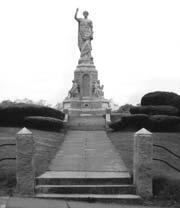The National Monument to the Forefathers is located on an approximately 11 acre, hilltop site on Allerton Street in Plymouth, just west of Plymouth Harbor and downtown. The 81 ft tall granite monument consists of an octagonal base surrounded by figures representing morality, law, education and liberty and surmounted by an allegorical representation of faith. Four marble panels mounted on the base depict scenes from Pilgrim history.
Designed by the noted Boston architect, illustrator and sculptor Hammatt Billings and completed in 1889, the National Monument to the Forefathers is said to be the largest solid granite monument in the world. The grounds surrounding the monument also date to the late nineteenth century, when a circular drive, pedestrian paths, decorative fence and entry posts were constructed. Today, the landscape provides opportunities for passive recreation. It is estimated that 250,000 people visit the site every year.
Constructed by the Pilgrim Society, the monument and grounds remained in that organization’s care until 2001, when the property was deeded to the Commonwealth of Massachusetts and became a satellite facility of Pilgrim Memorial State Park under the management of the DCR. The property is listed on the National Register of Historic Places.
Project Summary
The 2006 National Monument to the Forefathers RMP builds on a 2002 conditions assessment of the monument and on existing research into the evolution of the landscape. The RMP provides a framework for future management decisions and capital improvements at the property. Specific project goals include:
- Protection of the property’s natural and cultural resources
- Restoration of the site’s historic character
- Identification of maintenance and management priorities
- Sound management of public access and recreational use
- Consideration of the property’s role vis-à-vis other nearby tourist destinations and public parks, notably Plymouth Rock and Myles Standish Monument State Reservation
- Increasing public understanding of the natural, cultural and historic significance of the property
- Identification of potential funding mechanisms and programs, including public / private partnerships
- Identification of ways for members of the community (e.g., Friends groups) to remain or become involved with the ongoing maintenance and management of the property
- Identification of maintenance activities and early action projects that may be implemented in the short term
RMP documents
Contact for National Monument to the Forefathers Resource Management Plan
Online
Phone
Open M-F 9am-5pm
